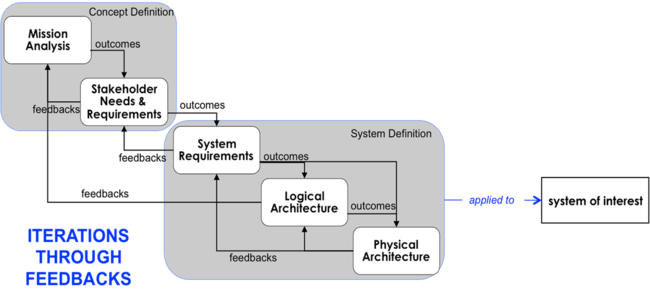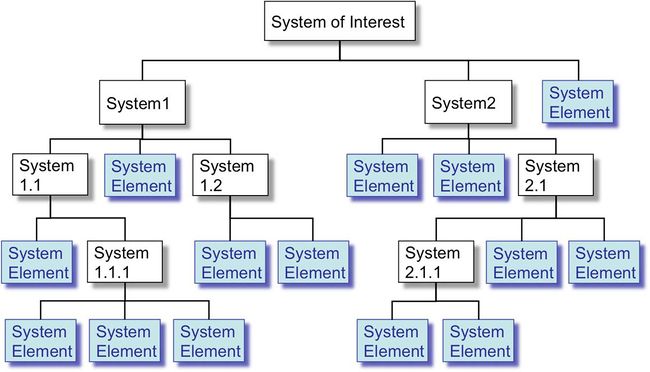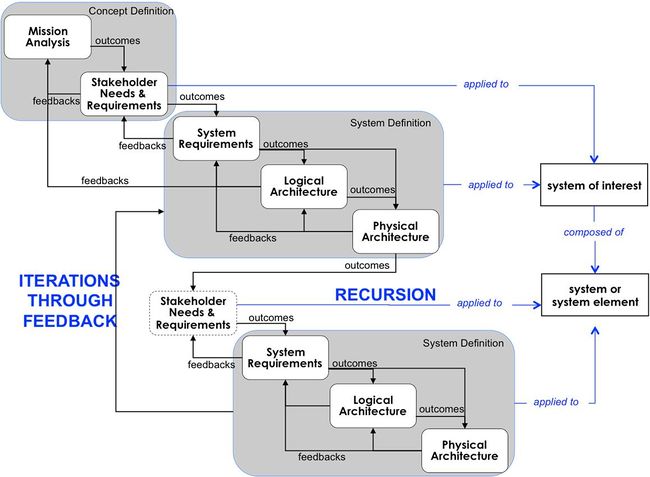Applying Life Cycle Processes
The concept of iteration is also applied to processes. Figure 2 below gives an example of iteration in life cycle processes. The processes in this example are further discussed in the System Definition KA.
The comprehensive definition of a SoI is generally achieved using decomposition layers and system elements . Figure 3 presents a fundamental schema of a system breakdown structure.
In each decomposition layer and for each system, the System Definition processes are applied recursively because the notion of "system" is in itself recursive; the notions of SoI, system, and system element are based on the same concepts (see Part 2). Figure 4 shows an example of the recursion of life cycle processes.
References
Works Cited
Collins English Dictionary, s.v. "Ontology." 2011.
Faisandier, A. 2012. Systems Architecture and Design. Belberaud, France: Sinergy'Com.
INCOSE. 2012. Systems Engineering Handbook: A Guide for System Life Cycle Processes and Activities, version 3.2.2. San Diego, CA, USA: International Council on Systems Engineering (INCOSE), INCOSE-TP-2003-002-03.2.2.
ISO/IEC. 2003. Systems Engineering — A Guide for The Application of ISO/IEC 15288 System Life Cycle Processes. Geneva, Switzerland: International Organization for Standardization (ISO)/International Electrotechnical Commission (IEC), ISO/IEC 19760:2003 (E).
ISO/IEC/IEEE. 2015. Systems and Software Engineering -- System Life Cycle Processes. Geneva, Switzerland: International Organisation for Standardisation / International Electrotechnical Commissions / Institute for Electrical and Electronics Engineers. ISO/IEC/IEEE 15288:2015.
ISO. 2007. Systems Engineering and Design. Geneva, Switzerland: International Organization for Standardization (ISO). ISO 10303-AP233.
Oliver, D., T. Kelliher, and J. Keegan. 1997. Engineering Complex Systems with Models and Objects. New York, NY, USA: McGraw-Hill.
Primary References
INCOSE. 2012. Systems Engineering Handbook: A Guide for System Life Cycle Processes and Activities, version 3.2.2. San Diego, CA, USA: International Council on Systems Engineering (INCOSE), INCOSE-TP-2003-002-03.2.2.
ISO/IEC/IEEE. 2015. Systems and Software Engineering -- System Life Cycle Processes. Geneva, Switzerland: International Organisation for Standardisation / International Electrotechnical Commissions. ISO/IEC/IEEE 15288:2015.
Additional References
Bell Telephone Laboratories. 1982. Engineering and Operations in the Bell System. Murray Hill, NJ: Bell Telephone Laboratories.
Fortescue, P.W., J. Stark, and G. Swinerd. 2003. Spacecraft Systems Engineering. New York, NY, USA: J. Wiley.
SEBoK Discussion
Please provide your comments and feedback on the SEBoK below. You will need to log in to DISQUS using an existing account (e.g. Yahoo, Google, Facebook, Twitter, etc.) or create a DISQUS account. Simply type your comment in the text field below and DISQUS will guide you through the login or registration steps. Feedback will be archived and used for future updates to the SEBoK. If you provided a comment that is no longer listed, that comment has been adjudicated. You can view adjudication for comments submitted prior to SEBoK v. 1.0 at SEBoK Review and Adjudication. Later comments are addressed and changes are summarized in the Letter from the Editor and Acknowledgements and Release History.
If you would like to provide edits on this article, recommend new content, or make comments on the SEBoK as a whole, please see the SEBoK Sandbox.
blog comments powered by Disqus

